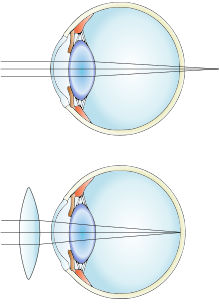Loading AI tools
Eye condition in which light is focused behind instead of on the retina From Wikipedia, the free encyclopedia
Far-sightedness, also known as long-sightedness, hypermetropia, and hyperopia, is a condition of the eye where distant objects are seen clearly but near objects appear blurred. This blur is due to incoming light being focused behind, instead of on, the retina due to insufficient accommodation by the lens.[6] Minor hypermetropia in young patients is usually corrected by their accommodation, without any defects in vision.[2] But, due to this accommodative effort for distant vision, people may complain of eye strain during prolonged reading.[2][7] If the hypermetropia is high, there will be defective vision for both distance and near.[2] People may also experience accommodative dysfunction, binocular dysfunction, amblyopia, and strabismus.[3] Newborns are almost invariably hypermetropic, but it gradually decreases as the newborn gets older.[6]
| Far-sightedness | |
|---|---|
| Other names | Hypermetropia, hyperopia, longsightedness, long-sightedness[1] |
 | |
| Far-sightedness without (top) and with lens correction (bottom) | |
| Specialty | Ophthalmology, optometry |
| Symptoms | Near blur, Distance and near blur, Asthenopia[2] |
| Complications | Accommodative dysfunction, binocular dysfunction, amblyopia, strabismus[3] |
| Causes | Axial length of eyeball is too short, lens or cornea is flatter than normal, aphakia[2] |
| Risk factors | Ageing, hereditary[2] |
| Diagnostic method | Eye exam |
| Differential diagnosis | Amblyopia, retrobulbar optic neuropathy, retinitis pigmentosa sine pigmento[4] |
| Treatment | Eyeglasses, contact lenses, refractive surgeries, IOL implantation[2] |
| Frequency | ~7.5% (US)[5] |
There are many causes for this condition. It may occur when the axial length of eyeball is too short or if the lens or cornea is flatter than normal.[2] Changes in refractive index of lens, alterations in position of the lens or absence of lens are the other main causes.[2] Risk factors include a family history of the condition, diabetes, certain medications, and tumors around the eye.[5][4] It is a type of refractive error.[5] Diagnosis is based on an eye exam.[5][8]
Management can occur with eyeglasses, contact lenses, or refractive corneal surgeries.[2] Glasses are easiest while contact lenses can provide a wider field of vision.[2] Surgery works by changing the shape of the cornea.[5] Far-sightedness primarily affects young children, with rates of 8% at 6 years old and 1% at 15 years old.[9] It then becomes more common again after the age of 40, known as presbyopia, affecting about half of people.[4] The best treatment option to correct hypermetropia due to aphakia is IOL implantation.[2]
Other common types of refractive errors are near-sightedness, astigmatism, and presbyopia.[10]
In young patients, mild hypermetropia may not produce any symptoms.[2] The signs and symptoms of far-sightedness include blurry vision, frontal or fronto temporal headaches, eye strain, tiredness of eyes etc.[2] The common symptom is eye strain. Difficulty seeing with both eyes (binocular vision) may occur, as well as difficulty with depth perception.[1] The asthenopic symptoms and near blur are usually seen after close work, especially in the evening or night.[6]
Far-sightedness can have rare complications such as strabismus and amblyopia. At a young age, severe far-sightedness can cause the child to have double vision as a result of "over-focusing".[11]
Hypermetropic patients with short axial length are at higher risk of developing primary angle closure glaucoma, so routine gonioscopy and glaucoma evaluation is recommended for all hypermetropic adults.[12]
Simple hypermetropia, the most common form of hypermetropia, is caused by normal biological variations in the development of eyeball.[2] Aetiologically, causes of hypermetropia can be classified as:
Far-sightedness is often present from birth, but children have a very flexible eye lens, which helps to compensate.[14] In rare instances, hyperopia can be due to diabetes, as well as problems with the blood vessels in the retina.[1]


A diagnosis of far-sightedness is made by utilizing either a retinoscope or an automated refractor-objective refraction; or trial lenses in a trial frame or a phoropter to obtain a subjective examination. Ancillary tests for abnormal structures and physiology can be made via a slit lamp test, which examines the cornea, conjunctiva, anterior chamber, and iris.[15][16]
In severe cases of hyperopia from birth, the brain has difficulty in merging the images that each individual eye sees. This is because the images the brain receives from each eye are always blurred. A child with severe hyperopia can never see objects in detail. If the brain never learns to see objects in detail, then there is a high chance of one eye becoming dominant. The result is that the brain will block the impulses of the non-dominant eye. In contrast, the child with myopia can see objects close to the eye in detail and does learn at an early age to see objects in detail.[medical citation needed]

Hyperopia is typically classified according to clinical appearance, its severity, or how it relates to the eye's accommodative status.[citation needed]
There are three clinical categories of hyperopia.[3]
There are also three categories severity:[3]
Accommodation has significant role in hyperopia. Considering accommodative status, hyperopia can be classified as:[7][2]
So, Total hyperopia= latent hyperopia + manifest hyperopia (facultative + absolute)[7]
The simplest form of treatment for far-sightedness is the use of corrective lenses, i.e. eyeglasses or contact lenses.[17][18] Eyeglasses used to correct far-sightedness have convex lenses.[19]
There are also surgical treatments for far-sightedness:
Laser procedures
IOL implantation
Non laser procedures
The term hyperopia comes from Greek ὑπέρ hyper "over" and ὤψ ōps "sight" (GEN ὠπός ōpos).[27]
Seamless Wikipedia browsing. On steroids.
Every time you click a link to Wikipedia, Wiktionary or Wikiquote in your browser's search results, it will show the modern Wikiwand interface.
Wikiwand extension is a five stars, simple, with minimum permission required to keep your browsing private, safe and transparent.